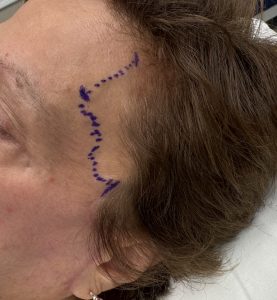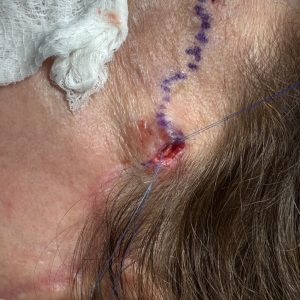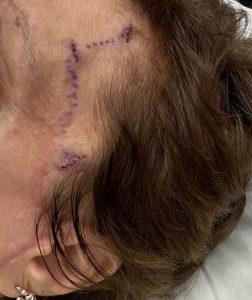Introduction
Prominent temporal arteries are typically an aesthetic concern, and their underlying cause is often unclear. While there are rare medical reasons for their appearance, most cases are benign and cosmetic in nature. These vascular prominences are frequently misdiagnosed as veins; however, their serpiginous course from the temples into the forehead and their pulsatile nature should make the diagnosis relatively straightforward.
Prominent temporal arteries are most commonly observed in men, likely due to their larger vessel size and thicker muscular walls. They also occur in women, though typically to a lesser degree. In females, there is often an identifiable cause, such as compression or entrapment from prior facial procedures, including thread lifts or facelift incisions.
Case Study


F
Discussion
Compression of the temporal artery can lead to its postoperative prominence. In this case, the left artery was not visible before the facelift and became prominent immediately after surgery, suggesting a procedure-related cause.
The precise mechanism is uncertain, but two possibilities are likely:
-
Proximal arterial ligation: The main temporal artery may have been ligated near the helical root, leading to backflow and dilation of the distal arterial branches.
-
Mechanical compression: Elevation of the skin flap and SMAS imbrication during the facelift may have caused localized vascular compression.
Regardless of the mechanism, treatment remains consistent: multilevel arterial ligation.
Typically, three ligation points—proximal (near the hairline), distal (forehead region), and central (midcourse)—are the minimum required for effective correction. Intraoperative Doppler assessment ensures success: the absence of a Doppler signal along the arterial path confirms complete interruption of blood flow. If a residual signal persists, additional ligation points should be added until flow is abolished.
Conclusions
-
Although rare, facelift surgery can cause compression of the superficial temporal artery, resulting in postoperative arterial prominence.
-
At least three ligation points are typically required for effective treatment.
-
Intraoperative Doppler evaluation is essential to confirm successful arterial interruption.
Barry Eppley, MD, DMD
World-Renowned Plastic Surgeon


